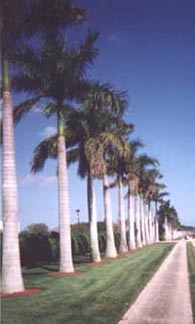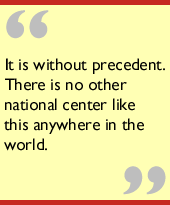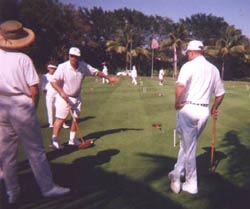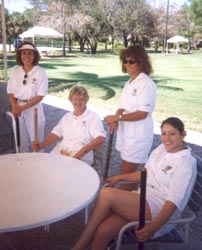

|
Back to |
| The Front Page |
| Archives |

|
Opening soon: croquet's national home in West Palm Beach
by Bob Alman Posted March 02, 2000 |
|
||||||
"Some people are going to be shocked," Chuck Steuber confided over lunch at Testa's in Palm Beach. "We're going to have every kind of croquet, all it one place, going on at the same time." In a nutshell, that's the vision of this audacious project's creator and (so far) major funder. We had just come from the site, at the intersection of Summit and Florida Mango in West Palm Beach, where I snapped a photo of the last of the trash wood to be removed in preparation for leveling the lawns and installing irrigation.
|

|
When Steuber took over the presidency of the Croquet Foundation of American in 1997, he announced that building a national home for croquet would be his priority. Most people - including myself - heard that announcement as an admirable and noble goal, but something far out of reach of this small sport. This skepticism did not shake for an instant Steuber's resolve. Soon he had found a site, bought the land himself as a donation to the Foundation, commissioned an architect, and begun to look for contributors.

|
| THE NEAREST NEIGHBOR and the only other occupant of the 10-acre block reflects the demographics of a West Palm Beach neighborhood in transition. |

The failure to immediately take in Steuber's vision of the National Croquet Center is understandable - because it is without precedent. There is no other national center like this anywhere in the world. The croquet organization is usually somebody's tenant, with its identity and goals somewhat subordinated to the landlord's. Most recently, the USCA has been a tenant of PGA National and then Palm Beach Polo.
What might happen if American croquet could manage its own independent destiny, supported by a world-class expanse of 12 lawns and sufficient management and staffing to market a growing sport?

|
| CROQUET SCHOOLS like this one - on the lawns of Palm Beach Polo - can be held at the National Croquet Center without interfering with an array of other lawn events going on at the same time. |
The combination of the lawns, the courtside gazebos, and temporary quarters is sufficient to accommodate any and all kinds of croquet programs - resident club play and tournaments, USCA title events, major international competitions, year-round training and instruction, special programs for high school and college students, corporate golf croquet, and educational and promotional projects which have yet to be invented.
At the November opening, only the centerpiece will be missing: the building in the middle of the property which will house the USCA staff, the Croquet Foundation of America, a museum and trophy hall, a restaurant and caterer, a bar, the croquet shop, and lounge facilities adjacent to the courts. The enclosed building comprises 15,000 square feet, with another 4,000 square feet in covered porches and balconies. The wrap-around porches - elevated for perfect viewing of the games - will promote a casual and convivial social environment reminiscent of England's Hurlingham. The resemblance is no accident.
 Architect Digby Bridges signed on early to Steuber's vision, coloured by his own history as a croquet player and as a respected architect of sports facilities. British-born, he moved to South Africa as a child, where his family played casual croquet in Johannesburg with their neighbors, the Barlows. (Yes, the same Barlows who today manufacture the sport's most widely used croquet balls.) Back in England in the mid-sixties, he joined the Hurlingham Club - headquarters of the British Croquet Association - and became a serious and very good player. His American Rules handicap is .5; he confesses to a slight preference for his native "Association Rules."
Architect Digby Bridges signed on early to Steuber's vision, coloured by his own history as a croquet player and as a respected architect of sports facilities. British-born, he moved to South Africa as a child, where his family played casual croquet in Johannesburg with their neighbors, the Barlows. (Yes, the same Barlows who today manufacture the sport's most widely used croquet balls.) Back in England in the mid-sixties, he joined the Hurlingham Club - headquarters of the British Croquet Association - and became a serious and very good player. His American Rules handicap is .5; he confesses to a slight preference for his native "Association Rules."
Among Bridges' commissions was the widely acclaimed Del Rey Tennis Center, a beautifully landscaped public facility accented by coconut palms boasting a stadium seating 13,000. The architecture is similar to that of the National Croquet Center. "The distinguishing feature of the Florida Keys style is wrap-around porches or verandahs," Bridges comments, "and those elevated spaces are perfect for watching games." Bridges goes to great lengths to incorporate elevated viewing spaces in all his designs for sporting facilities - including the new courts at the Beach Club in Palm Beach, with an elevated berm at one end providing a social focus for players and spectators.

|
| THE USCA STAFF will occupy temporary quarters at the new site while funds are being raised and construction completed on the main building. Here at Palm Beach Polo, their office is 100 yards from the courts. At the National Croquet Center, the biggest croquet lawn in America begins at their doorstep, embracing 12 courts in a single expanse, with turf for five nine-wicket courts in reserve. (left to right) Cheryl Harders, Diane Weir, Shereen Hayes, Amy Torres. |
Recreating the atmosphere of an English men's club in a Florida sports headquarters will be only one of the unique distinctions of the National Croquet Center. The final shape of the facility is planned out in every detail by Steuber and Bridges - who incidentally will remain intensely involved in every stage of the construction of buildings and lawns. How it is all managed to work together - the continuous array of activities, tournaments, and programs - has yet to be seen.
This project is not about bricks and mortar and grass; its real purpose is to provide a solid foundation for building the sport. A national home for croquet provides a strong focus for publicity, lawns for staging large "main events", space for ongoing instruction and training, and an infrastructure for marketing all forms of croquet to the business community, educational institutions, and the public.
It's really happening. Come to West Palm Beach and see it for yourself. Bring your mallet. Make your reservations early for pre-season play in November and December in West Palm Beach at croquet's new national home - before the courts fill up with member play and major events. I'll see you there!
MEMBERSHIPS AND DONATIONS in all amounts are now being accepted by the Croquet Founddation of America. Annual membership in the National Croquet Center Croquet Club costs $1000; founding members have full privileges beginning November 1, 2000, to January 1, 2002; Founding members who join the club and donate an additional $1001 will be acknowledged on a special brass plaque at the facility and honored as a member of the "2001 Club" of donors with special event offerings and a "2001 Club" pin. Affiliate membership in the National Croquet Center Croquet Club costs $250 and confers unlimited playing privileges for any 14 days of the membership year. Write your check to The Croquet Foundation of America and/or mail to 11585-B Polo Club Road, Wellington, Florida 33414.
